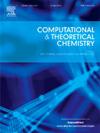Theoretical research of the NO and N2O reduction by char in oxy-fuel CFBC: Influence of H2O
IF 3
3区 化学
Q3 CHEMISTRY, PHYSICAL
引用次数: 0
Abstract
Oxy-fuel CFBC has lower NOx emissions compared to air combustion, with the high H2O content affecting NO and N2O reduction. This study, using density functional theory and transition state theory, investigates the impact of H2O on the char model at the electronic level and its subsequent influence on NO and N2O reduction. Results reveal that H2O adsorbs onto the active site on char, forming hydroxyl groups and free H atoms. The unstable O atom in –OH group leads to benzene ring rearrangement in the char model, creating additional active sites. NO reduction follows two paths: producing CO(R1) or CO2(R2). For N2O reduction(R3), N2O reduction precedes benzene ring cracking, with CO2 production providing more active sites. In R1, CO formation limits reactive sites and increases activation energy, while R2 and R3 favor CO2 formation. Reaction pathways leading to CO2 formation show lower activation energies and higher pre-exponential factors for N2 release.

求助全文
约1分钟内获得全文
求助全文
来源期刊

Computational and Theoretical Chemistry
CHEMISTRY, PHYSICAL-
CiteScore
4.20
自引率
10.70%
发文量
331
审稿时长
31 days
期刊介绍:
Computational and Theoretical Chemistry publishes high quality, original reports of significance in computational and theoretical chemistry including those that deal with problems of structure, properties, energetics, weak interactions, reaction mechanisms, catalysis, and reaction rates involving atoms, molecules, clusters, surfaces, and bulk matter.
 求助内容:
求助内容: 应助结果提醒方式:
应助结果提醒方式:


